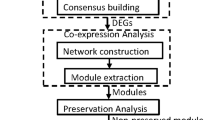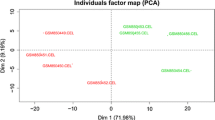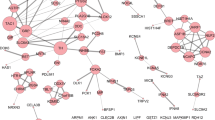Abstract
The enteric nervous system (ENS) is involved in the initiation and development of the pathological process of Parkinson’s disease (PD). The effect of rotenone on the ENS may trigger the progression of PD through the central nervous system (CNS). In this study, we used RNA-sequencing (RNA-seq) analysis to examine differential expression genes (DEGs) and pathways induced by in vitro treatment of rotenone in the enteric nervous cells isolated from rats. We identified 45 up-regulated and 30 down-regulated genes. The functional categorization revealed that the DEGs were involved in the regulation of cell differentiation and development, response to various stimuli, and regulation of neurogenesis. In addition, the pathway and network analysis showed that the Mitogen Activated Protein Kinase (MAPK), Toll-like receptor, Wnt, and Ras signaling pathways were intensively involved in the effect of rotenone on the ENS. Additionally, the quantitative real-time polymerase chain reaction result for the selected seven DEGs matched those of the RNA-seq analysis. Our results present a significant step in the identification of DEGs and provide new insight into the progression of PD in the rotenone-induced model.





Similar content being viewed by others
Abbreviations
- ADAMTS1:
-
A disintegrin and metalloprotease with thrombospondin motifs 1
- ANOVA:
-
Analysis of variance
- ATP:
-
Adenosine triphosphate
- CCK8:
-
Cell counting kit-8
- CNS:
-
Central nervous system
- DEGs:
-
Differential expression genes
- DMEM-HEPES:
-
Dulbecco’s modified eagle medium-2-hydroxyethyl
- DMSO:
-
Dimethylsulphoxide
- EDTA:
-
Ethylene diamine tetraacetic acid
- ENS:
-
Enteric nervous system
- FCS:
-
Fetal calf serum
- FPKM:
-
Fragment per kilobases of transcript per million fragments mapped
- GO:
-
Gene ontology
- KEGG:
-
Kyoto encyclopedia of genes and genomes
- MAPK:
-
Mitogen activated protein kinase
- MGP:
-
Matrix gla protein
- MPTP:
-
1-Methyl-4-phenyl-1,2,5,6-tetrahydropyridine
- NNAT:
-
Neuronatin
- NPY:
-
Neuropeptide Y
- PD:
-
Parkinson’s disease
- PNS:
-
Peripheral nervous system
- RNA-seq:
-
RNA-sequencing
- ROS:
-
Reactive oxygen species
- RT-PCR:
-
Real-time polymerase chain reaction
- SD rat:
-
Sprague–Dawley rat
- SEM:
-
Standard errors of mean
- SERPINE2:
-
Serpin peptidase inhibitor, clade E, member 2
- TH:
-
Tyrosine hydroxylase
- UGT8:
-
2-Hydroxyacylsphingosine 1-beta-galactosyltransferase
- WISP2:
-
Wnt1 inducible signaling pathway protein-2
References
Polito L, Greco A, Seripa D (2016) Genetic profile, environmental exposure, and their interaction in Parkinson’s disease. Parkinsons Dis 2016:6465793
Semchuk KM, Love EJ, Lee RG (1992) Parkinson’s disease and exposure to agricultural work and pesticide chemicals. Neurology 42(7):1328–1335
Berry C, La Vecchia C, Nicotera P (2010) Paraquat and Parkinson’s disease. Cell Death Differ 17(7):1115–1125
Braak H, de Vos RA, Bohl J, Del TK (2006) Gastric alpha-synuclein immunoreactive inclusions in Meissner’s and Auerbach’s plexuses in cases staged for Parkinson’s disease-related brain pathology. Neurosci Lett 396(1):67–72
Tasselli M, Chaumette T, Paillusson S et al (2013) Effects of oral administration of rotenone on gastrointestinal functions in mice. Neurogastroenterol Motil 25(3):e183–e193
Greene JG (2014) Causes and consequences of degeneration of the dorsal motor nucleus of the vagus nerve in Parkinson’s disease. Antioxid Redox Signal 21(4):649–667
Pan-Montojo F, Anichtchik O, Dening Y et al (2010) Progression of Parkinson’s disease pathology is reproduced by intragastric administration of rotenone in mice. PLoS One 5(1):e8762
Pan-Montojo F, Schwarz M, Winkler C et al (2012) Environmental toxins trigger PD-like progression via increased alpha-synuclein release from enteric neurons in mice. Sci Rep 2:898
Drolet RE, Cannon JR, Montero L, Greenamyre JT (2009) Chronic rotenone exposure reproduces Parkinson’s disease gastrointestinal neuropathology. Neurobiol Dis 36(1):96–102
Greene JG, Noorian AR, Srinivasan S (2009) Delayed gastric emptying and enteric nervous system dysfunction in the rotenone model of Parkinson’s disease. Exp Neurol 218(1):154–161
Liu Y, Sun JD, Song LK et al (2015) Environment-contact administration of rotenone: a new rodent model of Parkinson’s disease. Behav Brain Res 294:149–161
Betarbet R, Sherer TB, MacKenzie G, Garcia-Osuna M, Panov AV, Greenamyre JT (2000) Chronic systemic pesticide exposure reproduces features of Parkinson’s disease. Nat Neurosci 3(12):1301–1306
Fleming SM, Zhu C, Fernagut PO et al (2004) Behavioral and immunohistochemical effects of chronic intravenous and subcutaneous infusions of varying doses of rotenone. Exp Neurol 187(2):418–429
Cannon JR, Tapias V, Na HM, Honick AS, Drolet RE, Greenamyre JT (2009) A highly reproducible rotenone model of Parkinson’s disease. Neurobiol Dis 34(2):279–290
Wang X, Guan Q, Wang M et al (2015) Aging-related rotenone-induced neurochemical and behavioral deficits: role of SIRT2 and redox imbalance, and neuroprotection by AK-7. Drug Des Devel Ther 9:2553–2563
Batista LS, Denyer M, Britland S, Javid FA (2007) Development of an intestinal cell culture model to obtain smooth muscle cells and myenteric neurones. J Anat 211(6):819–829
De Paolo S, Salvemini M, Gaudio L, Aceto S (2014) De novo transcriptome assembly from inflorescence of Orchis italica: analysis of coding and non-coding transcripts. PLoS One 9(7):e102155
Yang W, Yoshigoe K, Qin X et al (2014) Identification of genes and pathways involved in kidney renal clear cell carcinoma. BMC Bioinform 15(Suppl 17):S2
Wang YZ, Dai MS, Zhang SJ, Shi ZB (2014) Exploring candidate genes for pericarp russet pigmentation of sand pear (Pyrus pyrifolia) via RNA-Seq data in two genotypes contrasting for pericarp color. PLoS One 9(1):e83675
Sun S, Xuan F, Ge X, Fu H, Zhu J, Zhang S (2014) Identification of differentially expressed genes in hepatopancreas of oriental river prawn, Macrobrachium nipponense exposed to environmental hypoxia. Gene 534(2):298–306
Karunakaran S, Ravindranath V (2009) Activation of p38 MAPK in the substantia nigra leads to nuclear translocation of NF-kappaB in MPTP-treated mice: implication in Parkinson’s disease. J Neurochem 109(6):1791–1799
Williamson CM, Beechey CV, Ball ST et al (1998) Localisation of the imprinted gene neuronatin, Nnat, confirms and refines the location of a second imprinting region on mouse chromosome 2. Cytogenet Cell Genet 81(1):73–78
Joseph RM (2014) Neuronatin gene: Imprinted and misfolded: studies in Lafora disease, diabetes and cancer may implicate NNAT-aggregates as a common downstream participant in neuronal loss. Genomics 103(2–3):183–188
Braak H, Rub U, Gai WP, Del TK (2003) Idiopathic Parkinson’s disease: possible routes by which vulnerable neuronal types may be subject to neuroinvasion by an unknown pathogen. J Neural Transm (Vienna) 110(5):517–536
Kann O, Kovacs R (2007) Mitochondria and neuronal activity. Am J Physiol Cell Physiol 292(2):C641–C657
Wong-Riley MT (1989) Cytochrome oxidase: an endogenous metabolic marker for neuronal activity. Trends Neurosci 12(3):94–101
Costantino-Ceccarini E, Poduslo JF (1989) Regulation of UDP-galactose:ceramide galactosyltransferase and UDP-glucose:ceramide glucosyltransferase after crush and transection nerve injury. J Neurochem 53(1):205–211
Bosio A, Binczek E, Stoffel W (1996) Molecular cloning and characterization of the mouse CGT gene encoding UDP-galactose ceramide-galactosyltransferase (cerebroside synthetase). Genomics 35(1):223–226
Wirthensohn T, Schoeberl P, Ghosh U, Fuchs W (2009) Pilot plant experiences using physical and biological treatment steps for the remediation of groundwater from a former MGP site. J Hazard Mater 163(1):43–52
Li R, Li X, Zhou M, Han N, Zhang Q (2012) Quantitative determination of matrix Gla protein (MGP) and BMP-2 during the osteogenic differentiation of human periodontal ligament cells. Arch Oral Biol 57(10):1408–1417
Marulanda J, Gao C, Roman H, Henderson JE, Murshed M (2013) Prevention of arterial calcification corrects the low bone mass phenotype in MGP-deficient mice. Bone 57(2):499–508
Fujita D, Terada S, Ishizu H et al (2003) Immunohistochemical examination on intracranial calcification in neurodegenerative diseases. Acta Neuropathol 105(3):259–264
Hannula MJ, Myohanen TT, Tenorio-Laranga J, Mannisto PT, Garcia-Horsman JA (2013) Prolyl oligopeptidase colocalizes with alpha-synuclein, beta-amyloid, tau protein and astroglia in the post-mortem brain samples with Parkinson’s and Alzheimer’s diseases. Neuroscience 242:140–150
Lorenzl S, Calingasan N, Yang L et al (2004) Matrix metalloproteinase-9 is elevated in 1-methyl-4-phenyl-1,2,3,6-tetrahydropyridine-induced parkinsonism in mice. Neuromolecular Med 5(2):119–132
Lee EJ, Woo MS, Moon PG et al (2010) Alpha-synuclein activates microglia by inducing the expressions of matrix metalloproteinases and the subsequent activation of protease-activated receptor-1. J Immunol 185(1):615–623
Reglodi D, Renaud J, Tamas A et al (2015) Novel tactics for neuroprotection in Parkinson’s disease: role of antibiotics, polyphenols and neuropeptides. Prog Neurobiol. doi:10.1016/j.pneurobio.2015.10.004
Decressac M, Pain S, Chabeauti PY et al (2012) Neuroprotection by neuropeptide Y in cell and animal models of Parkinson’s disease. Neurobiol Aging 33(9):2125–2137
Ji J, Jia S, Ji K, Jiang WG (2014) Wnt1 inducible signalling pathway protein-2 (WISP2/CCN5): roles and regulation in human cancers (review). Oncol Rep 31(2):533–539
Acknowledgements
This work was Supported by National Major Scientific and Technological Special Project for Significant New Drugs Development (2014ZX09102043-003), National Natural Science Foundation of China (No. 81371403, 81671273, 81171204, and 30772280), Shanghai Science and Technology Commission (No. 13JC1401102), the Project of Shanghai Municipal Education Commission of China (No. 14YZ046), the Projects of Shanghai Municipal Health and Family Planning Commission of China (No. 20124219 and 20134049), and the Project of Shanghai Jiao Tong University of China (No. YG2013MS22).
Author information
Authors and Affiliations
Corresponding author
Ethics declarations
Conflict of interest
The authors declare no potential conflict of interest.
Additional information
Qiang Guan and Xijin Wang have contributed equally to the manuscript.
Electronic supplementary material
Below is the link to the electronic supplementary material.
Rights and permissions
About this article
Cite this article
Guan, Q., Wang, X., Jiang, Y. et al. RNA-Seq Expression Analysis of Enteric Neuron Cells with Rotenone Treatment and Prediction of Regulated Pathways. Neurochem Res 42, 572–582 (2017). https://doi.org/10.1007/s11064-016-2112-9
Received:
Revised:
Accepted:
Published:
Issue Date:
DOI: https://doi.org/10.1007/s11064-016-2112-9




